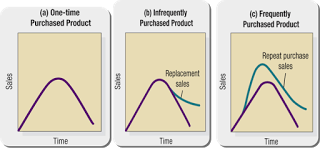Li (2000) highlights the importance of a marketing strategy
in setting a structure and direction to the specific marketing activities for
that product to aid it in meeting the set marketing objectives. Kotler
and Keller (2012) identified the following three main elements of a marketing
strategy:
· Target
Market – Who the target market is and why, and what is the size, structure and
characteristics of the market.
· Initial
Price, Distribution and Promotion – What will the price be and how will it be
distributed and promoted.
· Long
Term Goals – What are the sales and profit goals and what is the long term
marketing mix.
Prior to the
release of a golf GPS application by iGolf, the organisation developed a
marketing plan. This included a market
analysis identifying the broad target market as golfers who owned cellular
phones. Their plan included statistics
collected from many different sources resulting in iGolf calculating an
accurate target market size of 1.82 million.
iGolf’s pricing
strategy included a comparison of competitor’s prices and an explanation to
their plan to set a premium price using brand reputation to target the product
towards those looking for a quality product.
The promotional plan was aligned with past L1 Technologies products with
a small percentage of the product development budget being spent on promotional
activities. In addition the plan
included a sales strategy and six marketing objectives although these could be
improved by making them SMART.
Gymathlon’s target
market is regular gym users. In England
in 2008/09, 14.7% of the 60% of men and 13.4% of the 46% of women who take part
in sport go to gym. 51% of fitness
participants were men and 49% women, therefore the competition could
potentially appeal to both genders. Of
those gym users participating in weight training 84% were men, taking this into
account the women’s circuit could be adapted to make the sport more appealing
to the female market (DCMS,2011).
Gymathlon’s
competition includes Personal Trainers and fitness classes, their prices are
shown in Appendix A. Using this
information the price for a session of Gymathlon would be £20.00. This takes into account the need for a referee
to record scores and the cost of the use of facilities. Although this is higher than other activities
the opportunity to compete and test fitness with the opportunity to win should
encourage sales.
Distribution would
be through leisure centres and the competition would be promoted through the
centres as well as being showcased at events such as triathlons and other
endurance competitions. The long term
aims include gaining enough participants to run competitions between different
gyms and regions.
Activity
|
Price
|
Personal
Trainer Session
|
£35.00
|
Yoga
|
£7.40
|
Gym
Session
|
£6.70
|
Aquafit
|
£4.65
|
Swimming
|
£3.90
|
Krunch
& Kore
|
£3.80
|
Boxercise
|
£3.50
|
Metafit
|
£3.00
|
References
BSmart Fitness (2013) ‘Membership, Fees, Prices and Pay as
You Go’. Available at: http://www.b-smartfitness.co.uk/#!classes/c1yws
(Accessed: 2 December 2014).
DCMS (2011) ‘Adult participation in Sport’. Available at: https://www.gov.uk/government/uploads/system/uploads/attachment_data/file/137986/tp-adult-participation-sport-analysis.pdf (Accessed:
2 December 2014). Freedom Leisure (2014) ‘Woking Leisure Centre activity prices’. Available at: http://m.freedom-leisure.co.uk/centrepage.asp?section=871§ionTitle=woking+leisure+centre+activity+prices (Accessed: 2 December 2014).
iGolf (2014) ‘Company Info’. Available at: https://www.igolf.com/#ft_companyInfo
(Accessed: 2 December 2014).
Kelsey Kerridge (2014) ‘Fitness Classes’. Available at: http://www.kelseykerridge.co.uk/index.php?pageid=4007
(Accessed: 2 December 2014).Kotler, P. & Armstrong, G. (2012) Principles of Marketing. 14th edn. London: Pearson Education.
Kotler, P. & Keller, K.L. (2012) A Framework for Marketing Management. 5th edn. Harlow: Pearson Education.
Li, S. (2000). ‘The development of a hybrid intelligent
system for developing marketing strategy’. Decision Support Systems, 27(4),
pp. 395-409.
Midlothian Council (2014) ‘Leisure Centre Prices’. Available
at: http://www.midlothian.gov.uk/info/524/prices_and_memberships/690/leisure_centre_prices
(Accessed: 2 December 2014).
Sport England (2014) ‘Who plays Sport?’. Available at: https://www.sportengland.org/research/who-plays-sport/by-sport/
(Accessed: 2 December 2014).
Studio Fitness NE Ltd (2014) ‘Membership’. Available at: http://www.studio-fitness.co.uk/membership.html
(Accessed: 2 December 2014). 

Received
ReplyDelete